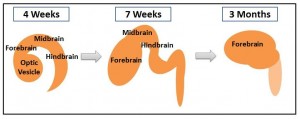Development
A recent study suggested that early brain cell development is different in people with Autism Spectrum Disorder (ASD) than in their developing peers. Explore this page to learn about how the brain develops.

Autism Spectrum Disorder (ASD) is a Pervasive Developmental Disorder associated with developmental differences in the brain, including changes in the size of some brain regions and differences in the number of cells in certain parts.To begin to understand how autism comes about, we need to know how the brain develops, from before birth to adulthood. We also need to know why children's brains are so susceptible to change. This vulnerability is both bad and good news. The bad news is that children's brains are more vulnerable to damage from environmental factors than those of adults. The good news is that children's brains (and even those of adults) can be altered with targeted experience. That's what learning is all about!
Key Points
- Autism is a Pervasive Development Disorder.
- Babies initially grow "too many" neurons and synapses, which are then pruned back to the appropriate number.
- Children's brains are more vulnerable to environmental factors than those of adults.
- Different parts of the brain often develop at different times.
- Social skills, including language, develop during critical periods of development.
Misconception
All brain regions and neural circuits develop at the same time in development.
Fact
Different brain regions often develop at different times.
Read about other misconceptions.

